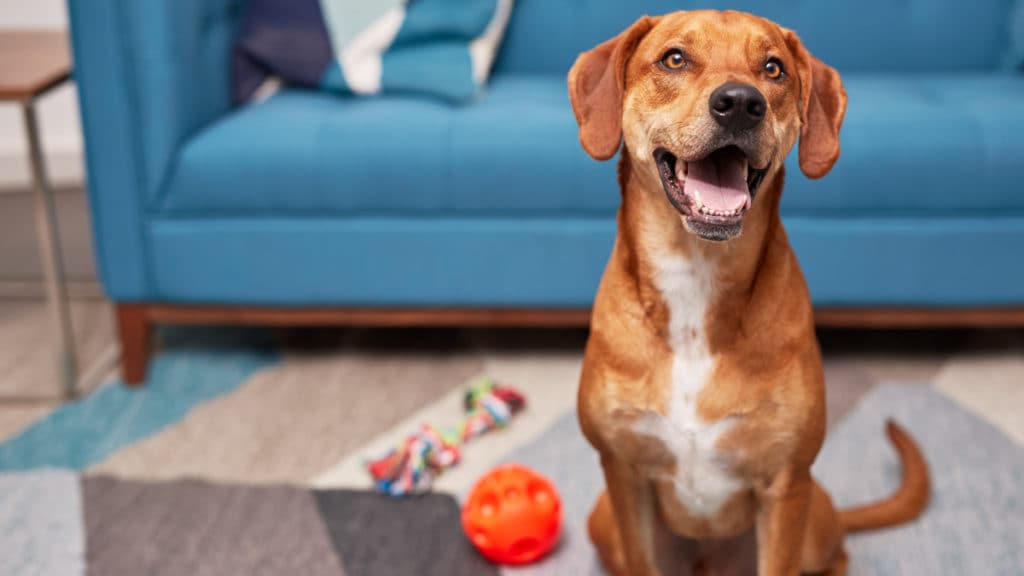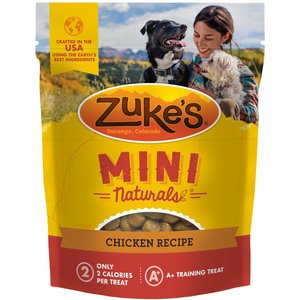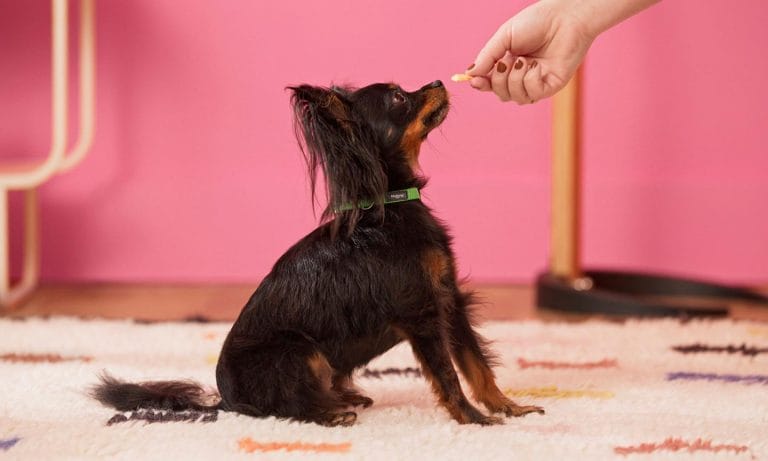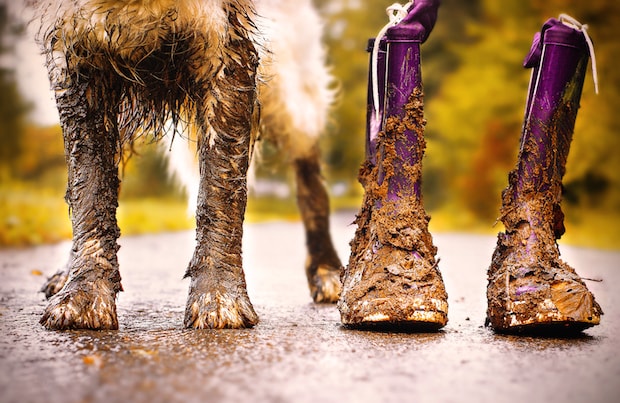Contributed by Irith Bloom, faculty at Victoria Stilwell Academy and certified animal trainer with multiple certifications, including CPDT-KSA, CDBC, VSPDT, KPA CTP, and CBATI.
My dog Franklin used to have a bad habit of jumping on guests when they entered my home. I found this embarrassing, even though I was lucky that most of my visitors were dog lovers who didn’t really mind too much. Some guests, however, were not huge fans of dogs in general, and found being jumped on distasteful or even uncomfortable. I knew it was time for some dog training.
When thinking about how to train a dog not to jump, it’s important to consider the purpose of the jumping, from the dog’s point of view. For most excited dogs like Franklin, the goal of jumping on people is interaction. Jumping up lets excited dogs smell and see more of our bodies. Excited dogs often want attention, such as being petted or talked to. Unfortunately, many dogs have learned that jumping up is a great way to get attention, which was certainly the case for Franklin.
In dog training or puppy training, the key is always to focus on reinforcing behavior that we like, and avoid reinforcement of behavior we don’t like. Note that I didn’t say “punish” or “correct” behavior we don’t like. That is because in many cases, so-called punishment or correction can have the opposite effect from what we want.
Since excited dogs often jump up to get attention, saying “No” to a dog, or pushing him down as he jumps, may actually make him more likely to jump up again. After all, you just gave the dog attention, right? In fact, all these years later, while Franklin no longer jumps on 99.9% of my guests, there is still one guest he jumps on just a little. It’s the one who could not simply ignore him, but instead would say “No” and push Franklin down when he jumped. With everyone else, Franklin keeps all four paws on the ground, but with her, he still lifts up his front paws slightly for a moment before he settles.
Whether you are looking to train a dog not to jump or dealing with another behavior issue, the best way to get rid of a behavior you don’t like is to train a different behavior that is incompatible with the undesired behavior (in other words, these behaviors cannot be done at the same time). Here are three ways to train your dog to do something other than jumping when guests arrive:
1. Set up a Barrier
Place a barrier, such as an ex-pen or a baby gate like the Carlson Pet Products Extra Wide Walk-Thru Gate with Pet Door, at a reasonable distance away from the door. Because of the layout of my entryway, setting up a barrier was not going to be easy in my case, so I couldn’t do this with Franklin, but I do recommend it highly.
Once the barrier is set up, put the dog behind it when people come to the door. Help keep your dog happy back there by giving him treats, such as Blue Buffalo Blue Bits Tasty Chicken Recipe Dog Training Treats. Scatter dog treats on the floor behind the gate. Since your dog will need to look down to eat the treats, this will help him learn to keep all four paws on the ground as guests come in. After that, you can employ the “Sit to greet” training described next.
2. Teach Your Dog to Sit to Greet
This is what I decided to do, since a barrier was not a good option, and Franklin already knew how to sit on cue. Start out by using treats, such as Zuke’s Mini Naturals Chicken Recipe Dog Treats, to teach your dog to sit. Once your dog understands how to sit on cue, you can begin to teach your dog to sit when people walk up to him. To do this, have a person start approaching from far away, ideally while your dog is behind a barrier. As soon as the person steps forward, cue your dog to sit. Then feed your dog a treat for sitting. Continue feeding your dog treats while the person approaches, as long as the dog stays seated.
If at any point your dog pops out of the sit, have the person walk away, and start over. Keep practicing until your dog can stay seated until the person is in front of the dog, on the other side of the barrier. Have the person pet the dog and feed treats as long as the dog stays in a sit. If the dog jumps up, the person should walk away. Eventually, the dog will learn to sit automatically as people approach—before you even give the cue to sit—since he will realize that sitting when people come towards him earns treats and petting.
Once your dog is automatically sitting for petting and treats, repeat the procedure without the barrier, but with your dog on a leash so he can’t rush over to the guest. (If, like me, you can’t put up a barrier, you can use the leash right from the beginning.) Start at a far distance, as before, and have the guest walk away whenever the dog pops out of the sit. Once your dog is successful with a leash on, you can repeat the procedure again, starting from the same far distance, without the leash.
One more tip: If the person ignores your instructions and talks to or touches the dog when he jumps up, that is likely to undermine your training. Pick training assistants who can follow instructions while you practice, or you may wind up with one person who will always be jumped on when visiting.
3. Teach Your Dog to Go to a Mat on Cue
This is a great behavior for a variety of situations, not just jumping up. For example, Franklin has a mat he stays on during meals, so he’s not underfoot and is too far away to beg. You can use treats such as Fruitables Skinny Minis Apple Bacon Flavor Dog Treats or Wellness Soft Puppy Bites Lamb & Salmon Recipe Dog Treats. Then, whenever someone enters the house, send your dog to his mat. Once he is there, you can give him a treat or two, and then release him to greet the person, assuming the person likes dogs.
Cut your training treats into pieces that are no bigger than your pinky nail. The goal is to be able to feed lots of treats as we train without causing the dog to become overweight. One treat I like since it breaks into small pieces so easily is Stella & Chewy’s Duck Duck Goose Dinner Patties. This is technically a complete food, but dogs find it really tasty, and it’s a great choice for small dogs and dogs with sensitive tummies. I also like Real Meat Company Beef Jerky Bitz, which are easy to cut. All of these treats get two paws up from Franklin, whose motto is the more treats, the merrier.
Another option is to mix treats with your dog’s regular food in a small bag. The regular food will pick up the smell of the treats, and neither you nor the dog will know in advance if he’ll get his regular food or a treat for the next repetition.
No matter which treats and techniques you choose, remember that consistency is the key to success. Practice regularly, working at a level your dog can handle, and before you know it, your guests will be complimenting you on your well-behaved dog. (Except for that one person who still says “No” and pushes the dog down, that is. *sigh*)
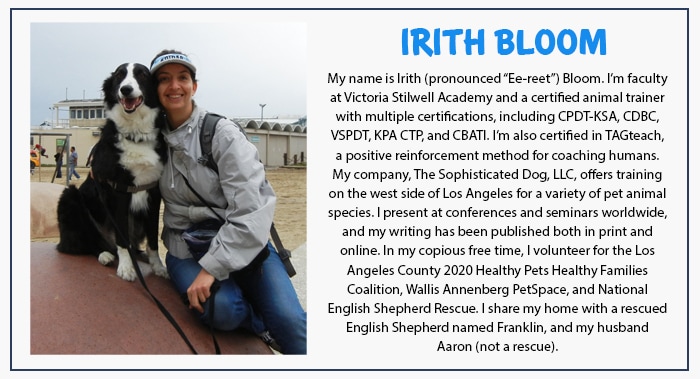
Share:
